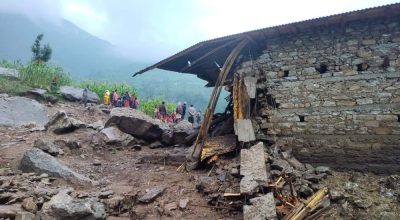
May 18 (AFP)
A powerful cyclone that formed in the bay of Bengal is headed directly for the India-Bangladesh border, bringing with it the potential for major destruction and upheaval in two countries that are still battling the COVID19 Pandemic
Cyclone Amphan has strengthened to the equivalent of a strong Category 4 Atlantic hurricane, or a super typhoon in the West Pacific. Amphan is packing winds of 150 mile per hour (240 kilometers per hour), though forecasters expect the storm will weaken before making landfall late Wednesday near the Ganges River Delta.
Even if the storm hits after weakening, it could cause significant damage. Amphan is forecast to make landfall near poor, densely populated areas with notoriously unreliable infrastructure. If it lands in the low-lying delta, there is also the potential for major storm surges, perhaps even as high as 30 feet (9 meters).
Natural disasters are tragically common in this part of the world, but this could be the first powerful storm ever to hit India and Bangladesh amid a global health emergency.
As of Monday morning, Bangladesh had identified at least 22,268 Covid-19 cases and 328 virus-related deaths, while India had counted at least 96,169 patients and 3,029 fatalities, according to the global list compiled by Johns Hopkins University.
Both countries have not yet slowed their rates of new infections.
Indian authorities said Monday the country identified more than 5,000 new coronavirus cases in the previous 24 hours, the highest number of cases identified in a single day since the pandemic began. Bangladesh recorded 1,273 new cases in the previous 24 hours, according to the country’s Ministry of Health and Family Welfare.
Juggling two disasters will be hard, especially when the measures for saving lives during a storm — such as setting up densely packed evacuation centers — are difficult to do while following social distancing measures.
The Indian state of Odisha has put 12 coastal districts on high alert, while neighboring West Bengal — which sits on India’s border with Bangladesh — has sounded a cyclone alert in its six coastal districts, including in Kolkata, one of India’s most populous cities with more than 4.4 million inhabitants.
SN Pradhan, the director general of India’s National Disaster Response Force (NDRF), said authorities are deploying 10 teams to Odisha and seven to West Bengal to start evacuation efforts. Twenty NDRF teams are on standby, Pradhan said.
The storm could also bring heavy rains to the world’s largest refugee camp in Cox’s Bazar, where almost 1 million Rohingya refugees live after fleeing violence in Myanmar’s Rakhine state.
A storm could be particularly devastating in the camp, especially when considering that the first known Covid-19 cases were confirmed there just last week.








प्रतिक्रिया दिनुहोस्